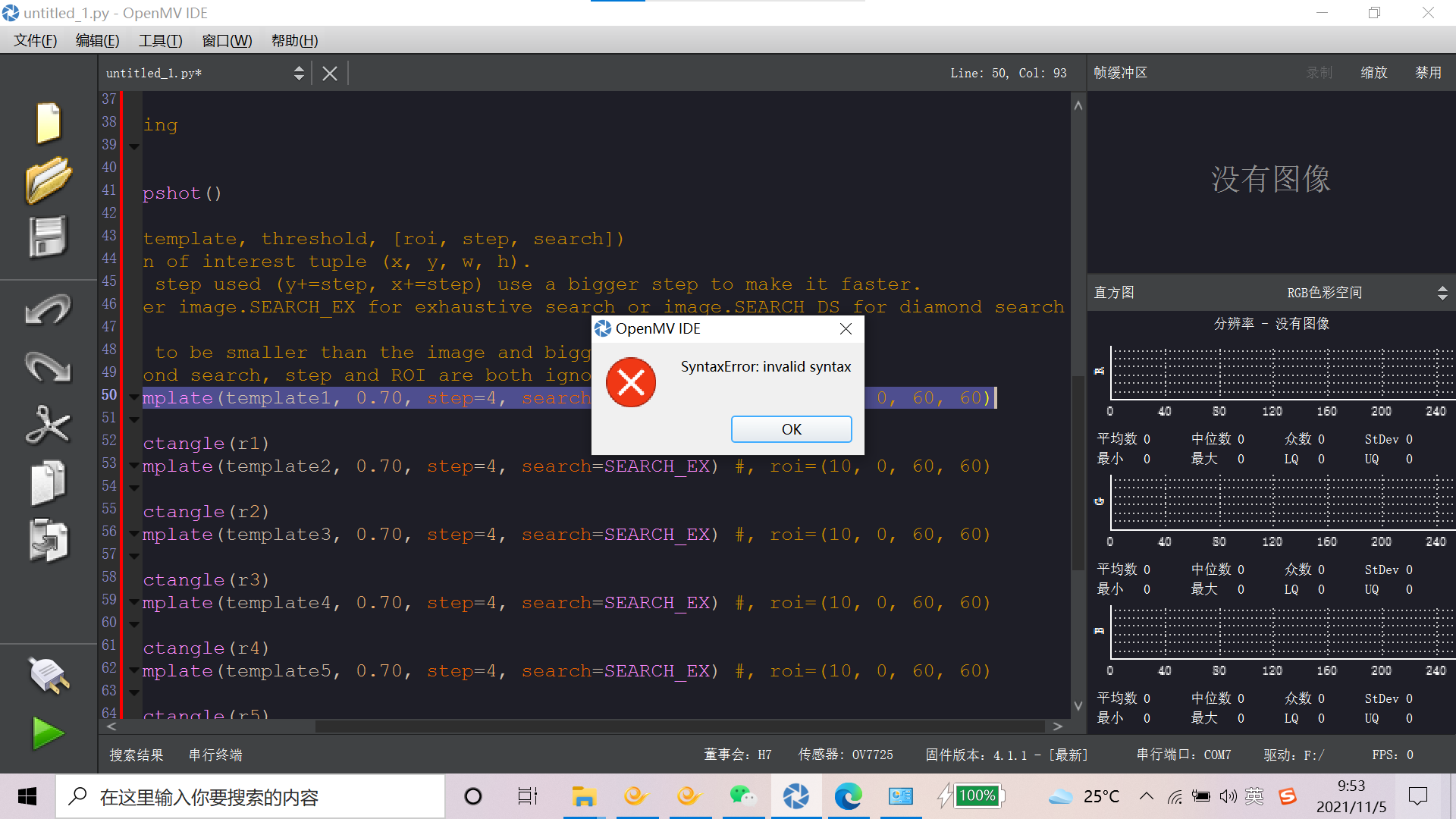我的板子是H7,进行多模板识别的时候总是报错,请问是什么原因呢?
-

请在这里粘贴代码Template Matching Example - Normalized Cross Correlation (NCC)
This example shows off how to use the NCC feature of your OpenMV Cam to match
image patches to parts of an image... expect for extremely controlled enviorments
NCC is not all to useful.
WARNING: NCC supports needs to be reworked! As of right now this feature needs
a lot of work to be made into somethin useful. This script will reamin to show
that the functionality exists, but, in its current state is inadequate.
import time, sensor, image
from image import SEARCH_EX, SEARCH_DSReset sensor
sensor.reset()
Set sensor settings
sensor.set_contrast(1)
sensor.set_gainceiling(16)Max resolution for template matching with SEARCH_EX is QQVGA
sensor.set_framesize(sensor.QQVGA)
You can set windowing to reduce the search image.
#sensor.set_windowing(((640-80)//2, (480-60)//2, 80, 60))
sensor.set_pixformat(sensor.GRAYSCALE)Load template.
Template should be a small (eg. 32x32 pixels) grayscale image.
template1 = image.Image("/1.pgm")
template2 = image.Image("/2.pgm")
template3 = image.Image("/3.pgm")
template4 = image.Image("/4.pgm")
template5 = image.Image("/5.pgm")
template6 = image.Image("/6.pgm")
template7 = image.Image("/7.pgm")
template8 = image.Image("/8.pgm")
clock = time.clock()Run template matching
while (True):
clock.tick()
img = sensor.snapshot()# find_template(template, threshold, [roi, step, search]) # ROI: The region of interest tuple (x, y, w, h). # Step: The loop step used (y+=step, x+=step) use a bigger step to make it faster. # Search is either image.SEARCH_EX for exhaustive search or image.SEARCH_DS for diamond search # # Note1: ROI has to be smaller than the image and bigger than the template. # Note2: In diamond search, step and ROI are both ignored. r 1= img.find_template(template1, 0.70, step=4, search=SEARCH_EX) #, roi=(10, 0, 60, 60) if r1: img.draw_rectangle(r1) r 2= img.find_template(template2, 0.70, step=4, search=SEARCH_EX) #, roi=(10, 0, 60, 60) if r2: img.draw_rectangle(r2) r 3= img.find_template(template3, 0.70, step=4, search=SEARCH_EX) #, roi=(10, 0, 60, 60) if r3: img.draw_rectangle(r3) r 4= img.find_template(template4, 0.70, step=4, search=SEARCH_EX) #, roi=(10, 0, 60, 60) if r4: img.draw_rectangle(r4) r 5= img.find_template(template5, 0.70, step=4, search=SEARCH_EX) #, roi=(10, 0, 60, 60) if r5: img.draw_rectangle(r5) r 6= img.find_template(template6, 0.70, step=4, search=SEARCH_EX) #, roi=(10, 0, 60, 60) if r6: img.draw_rectangle(r6) r 7= img.find_template(template7, 0.70, step=4, search=SEARCH_EX) #, roi=(10, 0, 60, 60) if r7: img.draw_rectangle(r7) r 8= img.find_template(template8, 0.70, step=4, search=SEARCH_EX) #, roi=(10, 0, 60, 60) if r8: img.draw_rectangle(r8) print(clock.fps())
-